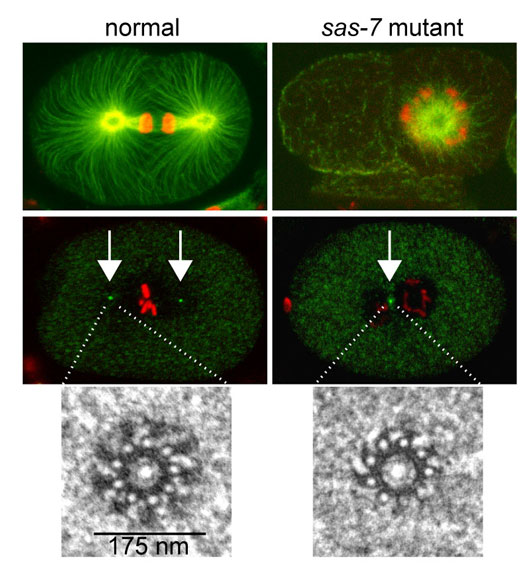In the dividing cells, two centriole pairs organize the formation of two spherical protein matrixes called centrosomes by recruiting numbers of proteins and allowing robust bipolar mitotic spindle formation to segregate chromosomes into daughter cells accurately. To maintain its number, each centriole in the pair generates a daughter centriole before cell division.
A powerful forward genetic screening in model organism C. elegans has identified five core centriole duplication proteins that were later found in human cells. Five core proteins, SPD-2, ZYG-1, SAS-5, SAS-6 and SAS-4, act sequentially to assemble the new centriole. Here, another C. elegans forward genetic screening identified a new gene essential for centriole duplication.
To date, SPD-2 is the earliest acting protein in the centriole duplication pathway that regulates all other core protein localization. However, a newly identified protein SAS-7 regulates the centriole localization of the SPD-2 protein and does not require SPD-2 for its localization, suggesting that SAS-7 acts upstream of SPD-2 and is the most upstream protein yet identified.

Figure: Centriole duplication defects in sas-7 mutants. Microtubule (green: upper panel), centriole protein SAS-4 (green: middle panel) and DNA (red) in dividing C. elegans zygotes. Bottom panels show transmission electron micrograph of the centriole structure. In sas-7 mutants, centriole duplication fails and the centriole lacks the paddlewheel structure (peripheral black dense region).
Interestingly, centriole duplication in sas-7 mutants has not failed randomly. The distribution of defects strongly supports the idea that the daughter centriole fails to duplicate while the mother had no such problem. Although daughter-specific defects have not been reported in C. elegans, similar defects occur in the mutants of the human cell. This process is called centriole-to-centrosome conversion, but the detailed mechanism remains unclear. Analysis by transmission electron microscopy also found that the centriole in sas-7 mutants lacked the structure called the paddlewheel. It is possible that such a structure is the key to understanding the mechanism that makes the daughter centriole acquire duplication competence.
In humans, failures in centriole duplication and formation are related to cancer, microcephaly, and ciliopathies such as Bardet-Biedl and Oral-Facial-Digital syndromes. The more we understand the centriole duplication process, the more likely we will have the chance to cure these problems. Now we know that centriole duplication processes in C. elegans and humans are even closer than we thought and it is expected that a SAS-7-like protein is working in human cells even though it has not been identified yet.
For more on this story see the press release and news item from the University of Oregon.
Reference
Centriolar SAS-7 acts upstream of SPD-2 to regulate centriole assembly and pericentriolar material formation. Sugioka, K., Hamill, D.R., Lowry, J.B., McNeely, M.E., Enrick, M., Richter, A.C., Kiebler, L.E., Priess, J.R., and Bowerman, B. (2017). eLife Jan 16;6. pii: e20353. doi: 10.7554/eLife.
Other references
Towards a molecular architecture of centriole assembly. Gönczy, P. (2012). Nature Reviews Molecular Cell Biology 13, 425-435.
Centrosomes and cancer: revisiting a long-standing relationship. (2015). Nature Reviews Cancer 15, 639-652. Gönczy, P.


































